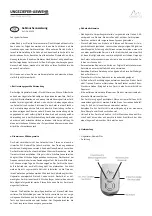
Pub. 42004-550A
Elemec3
Console Manual
—Version 3.0
Page 113 of 114
P:\Standard IOMs - Current Release\42004 Instr. Manuals\42004-550A.docx
09/20
Glossary of Terms
Term
Definition
A-B System
The arrangement of two
Elemec3
systems whereby redundancy is achieved
through coordinated duplicated operations. The B ‘Redundant’ system may
have some amplifiers excluded.
Access Panel
End user interface device used to control of alarms and to generate live speech
broadcasts. The panel is available in three formats—19-inch rack mounting,
desk mounting, and bulk-head mounting. Stalk or fist microphones are
available.
Access Panel
Muting
Method of feedback prevention by way of automatic disconnection of local
speakers during an access panel live speech broadcast. Disconnection employs
an output of an I/O controller.
Amplifier
Device containing one or two amplifier channels.
Attenuate
To reduce the broadcast volume by a specified amount. Audio is attenuated
either on-demand (from an access panel), or by a higher priority event (in
accord with the Global Audio Mix setup).
Aux 1–Aux 5
Designations for the five auxiliary audio channels (inputs to the controller).
IPAux 1–IPAux 8
Designations for the eight IP auxiliary audio channels (inputs to the controller).
Configuration
A named collection of settings that describe system behavior. The Elemec
Console application creates, modifies, and manages configurations. The
configuration is stored in a directory and consists of a main file (config.db) plus
several audio message (.mp3) files.
Controller
The central device of the PAGA system that coordinates audio routing and
event activation requests in accord with the configuration.
Contingent
Override
A type of event group that automatic substitutes a general event to occur if
multiple specific events initiate.
Elemec3 Portal
Software application that provides for viewing of an
Elemec3
system’s status,
for initiating Tick Tone, and for managing Configuration updates.
Event
A defined set of actions performed by the controller. An event may generate
audio, route audio, and activate outputs. Events are set up using the
Elemec3
Console application. At any given time, an event in the system is either active
or idle. Each event has many characteristics that govern the system’s response
to the activation of the event and to the event’s progression. Event types
include live speech, playback, record/playback, silent, and external.
Event Chaining
Elemec3
’s mechanism for allowing an Event to trigger another Event, with the
possibility of the trigger being dependent on the state of an input, an output, or a
Flag. A sequence of activations setup through chaining of Events.
Event Group
A collection of Playback Events.
Fault
A trouble condition detected within the system. Through
Elemec3
Console,
faults are categorized as either
Normal
or
Urgent (or Ignore)
depending on
their severity level. Set a fault to “Ignore” if it is considered insignificant; this
fault will never be displayed by
Elemec3
Portal application.
Global Mute
Time-limited suppression of audio in accord with one of four preset settings.

































